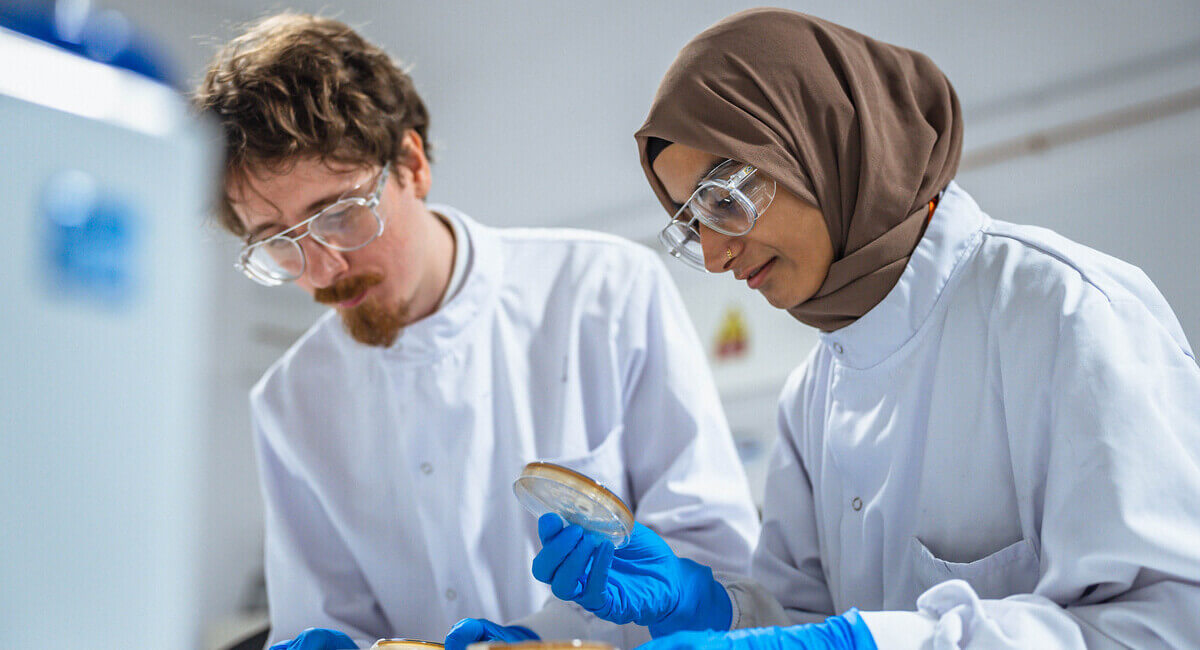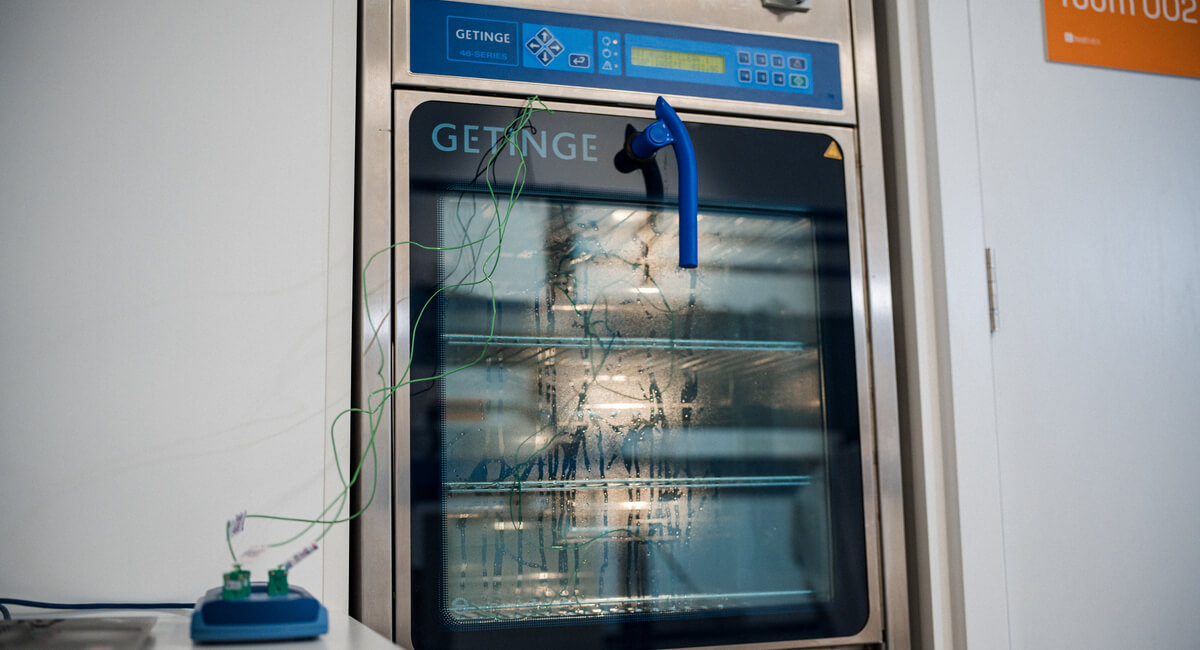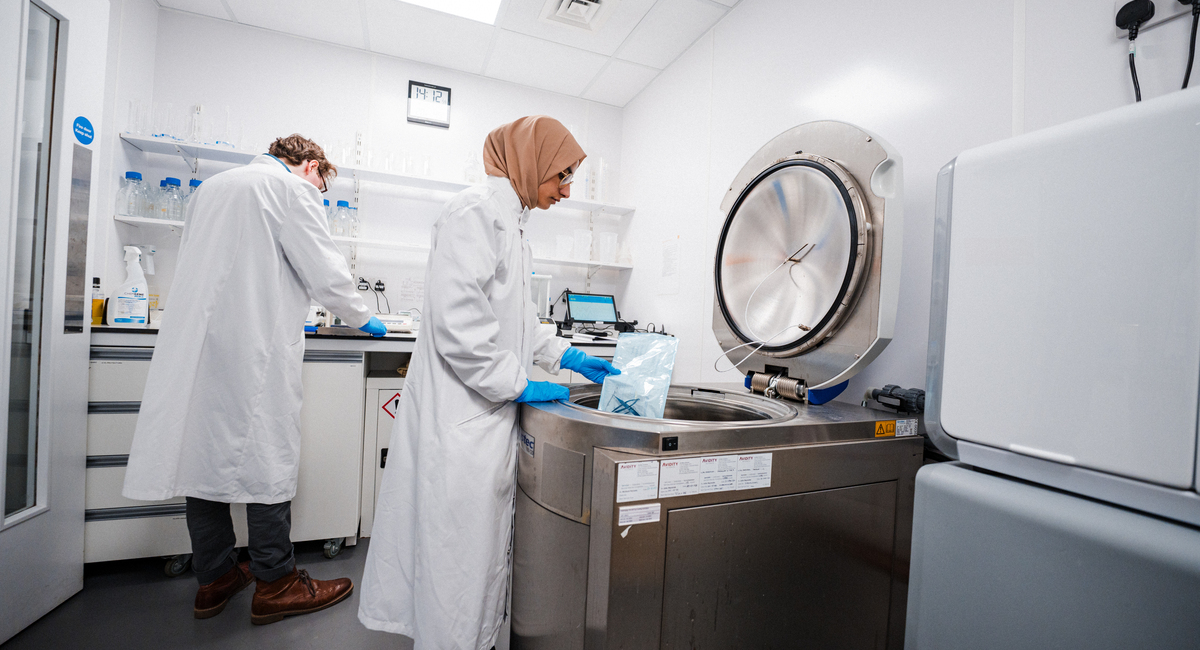Reusable Medical Device Validation: Everything You Need to Know
Article Summary
At Test Labs we validate cleaning, disinfection, and sterilisation of reusable medical devices to ensure safety, regulatory compliance, and durability. Our insights help medical device manufacturers produce devices that are effective, reliably reprocessable, and sustainable.Article Contents
How We Validate Reusable Medical Devices?
At Test Labs, we specialise in validating the cleaning, disinfection, and sterilisation processes of reusable medical devices. Our validation process includes both manual and automated methods.
Manual processes often involve hands-on cleaning and chemical disinfection and ensuring compliance with specific manufacturer guidelines and unique medical device requirements.
In contrast, automated systems are designed for high-throughput, providing consistent and repeatable results with increased efficiency and precision, especially for larger volumes of devices.
We outline our step-by-step validation process, the tools and standards we use, and the key lessons learned throughout our work.
What are Reusable Medical Devices and Why do they Require Validation?
Reusable medical devices are critical in modern healthcare, used repeatedly for patient care. From surgical instruments to flexible endoscopes, these devices must be rigorously validated to ensure they are safe and free from contamination after each use. Their reprocessing, detailed in the Instructions for Use (IFU), involves cleaning, disinfection, and sterilisation to meet safety standards.
Class Ir (Reusable) devices are designed for multiple uses, and they include high-risk tools that require sterilisation to prevent infections. These reusable medical devices are subject to strict reprocessing protocols to ensure safety with every reuse.
Common examples of Class Ir medical devices include:
- Surgical instruments (e.g., clamps, scissors).
- Orthopaedic tools (e.g., drills, saws).

How are Surgical Instruments and Endoscopes Classified for Reprocessing?
Reusable medical devices are categorised by their intended use, level of patient contact, and infection risk. High-risk instruments, such as those used in invasive surgery, must undergo rigorous validation to ensure reliable reprocessing and patient safety.
What is the Step-by-Step Validation Process for Reusable Medical Devices?
IFU validation typically consists of the following stages:
- Worst case justification (Master product selection).
- Cleaning Validation.
- Disinfection Validation.
- Sterilisation Validation.
- Drying validation (WD & Autoclave).
- Reprocessing (Life cycle validation).
We always design our studies to reflect worst-case scenarios, using medical devices with the hardest to reprocess design features and to simulate real-world usage as accurately as possible.
How is Cleaning Validation Performed in Medical Device Reprocessing?
Cleaning validation ensures the effective removal of contaminants from medical devices before disinfection or sterilisation. The process begins with device grouping, which considers factors such as use, material composition, and size/complexity. Next, soil selection reflects clinical use, and application methods simulate real contamination scenarios, including delays that may occur during reprocessing.
Cleaning methods, including manual, mechanical, and automated, are chosen based on device type, with enzymatic detergents preferred for their soil-removing power and gentler impact. After cleaning, rinsing, and residue extraction ensure thorough cleanliness.
In line with AAMI ST98 and ISO 15883 requirements, we conduct a minimum of six cleaning cycles, followed by residue analysis. We routinely test two analytes:
- Protein (Mandatory), based on a modified OPA assay;
- Haemoglobin, through an oxidative colorimetric assay with the use of TMB;
- Total Organic Carbon (TOC), which takes place using UV/persulfate oxidation and NDIR Detection.

How is Disinfection Validation Conducted for Medical Devices?
Disinfection validation ensures that microbial loads on reusable medical devices are reduced to safe levels. This is achieved through manual (Chemical) or automated disinfection (thermometric) methods.
Manual disinfection typically involves the use of chemical disinfectants, where the device is manually cleaned with a disinfectant solution, ensuring effective microbial reduction. Disinfection validation is performed by spiking the item with the organisms defined in TIR-12:2024 and then the viability of the microorganisms is assessed according to the criticality of the test item.
Automated disinfection uses specialised machines like washer-disinfectors, which employ heat to sanitise devices efficiently and consistently. Automated disinfection validation is based on the achievement of 90°C for 1 minutes, as per industry standards.
What is Sterilisation Validation and How is SAL Achieved?
Sterilisation validation ensures that medical devices are effectively sterilised for safe reuse. Our process includes key steps to guarantee the device’s sterility post-processing:
- Sterility Assurance Level (SAL) Validation: Achieved through overkill methods, ensuring a sterility level well below 10⁻⁶.
- Dry Time Validation: Verifying that the device is completely dry after sterilisation.
Sterilisation validation is based on the ‘overkill method’ in which we spike the test item with Geobacillus stearothermophilus and we aim to achieve a SAL of 10⁻⁶. The test items are then immersed in TSB, the recovery will take place mechanically and then the results are obtained by comparing organism growth in TSB and positive control.

What Lessons have we Learned from Validating Reusable Medical Devices?
One of the most eye-opening lessons we’ve learned is that you simply can’t assume devices will withstand repeated reprocessing, some begin to show serious wear after just 25 to 50 cycles, underscoring the need to validate service-life claims. We discovered that a device being effective in surgery isn’t enough: it must also be reliably cleanable for the very next patient.
Through validation, we’ve identified design features such as hidden hinges, tight lumens, incompatible materials, that pose a great challenge to achieving cleaning efficacy. These findings often allow us to offer advise through our consultative testing approach and medical device manufacturers on which methods of reprocessing are most effective for their medical devices.
We also regularly encounter devices whose IFUs, despite claims of being validated, fail acceptance criteria, even when followed precisely. Issues often stem from missing pre-cleaning steps, incorrect detergent dosage, or inadequate time/temperature specifications. This highlights why validated IFUs must include clear, detailed instructions from real-world testing, not just ideal scenarios.
Finally, by demonstrating that many devices can be effectively reprocessed, we support a more sustainable alternative to single-use products, reducing medical waste, lowering costs, and reinforcing environmental responsibility.
How Does Validation Support Patient Safety and Sustainability?
By ensuring that reusable medical devices can be effectively reprocessed, validation enhances patient safety, device performance, and sustainability. It reduces reliance on single-use devices, lowering waste and supporting environmentally responsible healthcare practices.
Which International Standards Govern Reusable Medical Device Validation?
At Test Labs, we adhere to the most rigorous international standards to ensure the highest quality and safety for reusable medical devices. Our commitment to compliance includes:
- MDR (EU Medical Device Regulation 2017/745) – Compliance with the latest EU regulations, showing our commitment to European market standards.
- 21 CFR (Code of Federal Regulations, Title 21) – Compliance with FDA regulations for medical devices in the US, demonstrating our commitment to meeting US market standards.
- ISO 17664-1:2021 – Information for the reprocessing of reusable medical devices, ensuring safe and effective cleaning, disinfection, and sterilisation.
- ANSI/AAMI ST98:2022 – Cleaning validation of healthcare products, underscoring our expertise in cleaning processes for reusable medical devices.
- AAMI TIR 12:2010 – Guidance on cleaning and disinfection validation, enhancing our ability to select and validate cleaning methods for reusable devices.
- ISO 158832:2024 – Performance requirements and test method criteria for demonstrating thermal disinfection efficacy.
- ISO 176651 – Sterilisation of health care products – Moist heat.
These standards guide our procedures, ensuring the safety of patients and personnel throughout the device’s lifecycle.
Why Medical Device Validation Matters for Manufacturers and Healthcare Providers
Our medical device validation process, from stress-testing devices across worst-case cleaning, disinfection, sterilisation, and UDI checks, goes far beyond ticking regulatory boxes. It delivers confidence.
We routinely uncover instruments failing functionality testing well before 50 reprocessing cycles, or IFUs that miss critical pre-cleaning or timing details. These insights drive medical device manufacturers to improve both design and instructions, ensuring that reusable medical devices are truly fit for purpose and not just in the operating room, but ready and safe for the next patient.
In summary, our validation ensures reusable devices are safe, and durable backed by actionable data. That’s Test Labs : empowering manufacturers and healthcare providers to deliver medical devices that are compliant, and high-performing.
Get It Done, With Certainty.
Contact us about your testing requirements, we aim to respond the same day.
Get resources & industry updates direct to your inbox
We’ll email you 1-2 times a week at the maximum and never share your information


